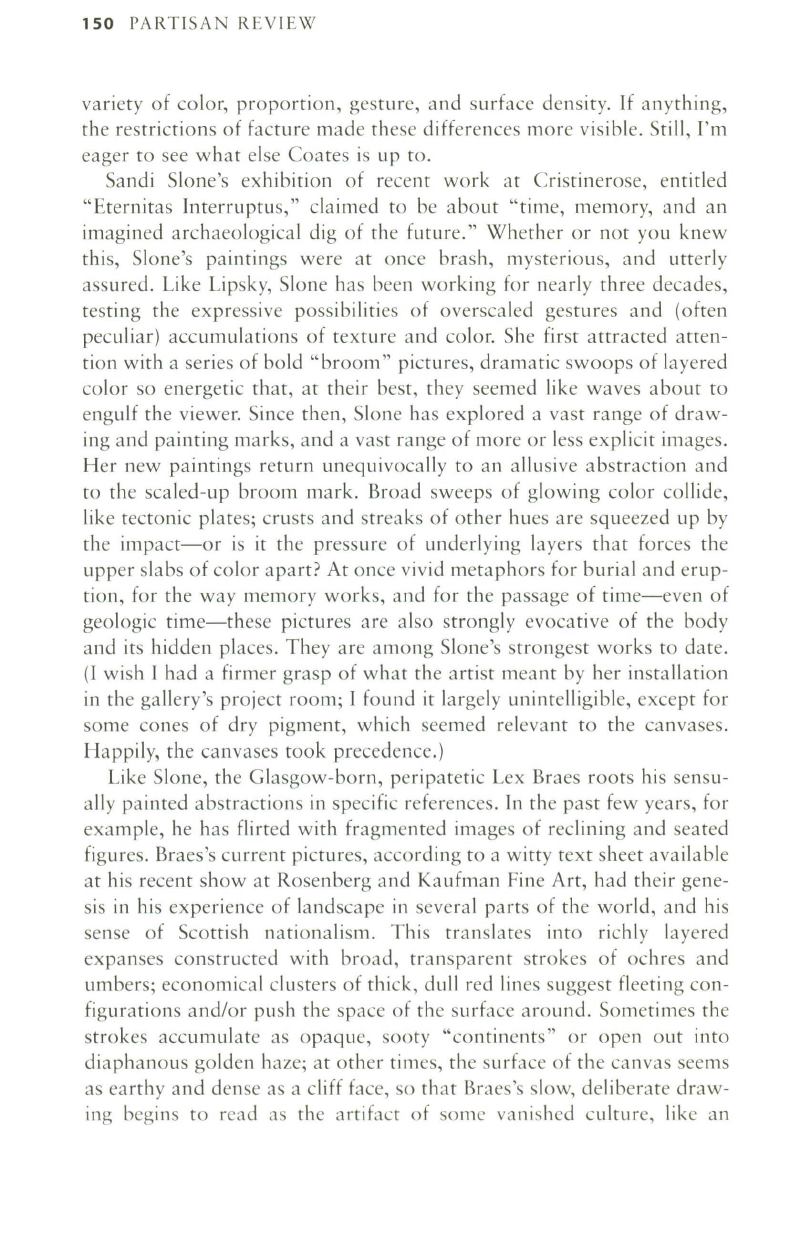
150
PARTISAN REVIEW
variety of color, proportion, gesture, and surface density.
If
anything,
the restrictions of facture made these differences more visible. Still, I'm
eager to see what else Coates is up
to.
Sandi Slone's exhibition of recent work at Cristinerose, entitled
"Eternitas Interruptus," claimed
to
be about "time, memory, and an
imagined archaeological dig of the future." Whether or not you knew
this, Slone's paintings were at once brash, mysterious, and utterly
assured. Like Lipsky, Slone has been working for nearly three decades,
testing the expressive possibilities of overscaled gestures and (often
peculiar) accumulations of texture and color. She first attracted atten–
tion with a series of bold "broom" pictures, dramatic swoops of layered
color so energetic that, at their best, they seemed like waves about
to
engulf the viewer. Since then, Slone has explored a vast range of draw–
ing and painting marks, and a vast range of more or less explicit images.
Her new paintings return unequivocally
to
an allusive abstraction and
to
the scaled-up broom mark. Broad sweeps of glowing color collide,
like tectonic plates; crusts and streaks of other hues are squeezed up by
the impact-or is it the pressure of underlying layers that forces the
upper slabs of color apart? At once vivid metaphors for burial and erup–
tion, for the way memory works, and for the passage of time-even of
geologic time-these pictures are also strongly evocative of the body
and its hidden places. They are among Slone's strongest works
to
date.
(I wish I had a firmer grasp of what the artist meant by her installation
in the gallery'S project room; I found it largely unintelligible, except for
some cones of dry pigment, which seemed relevant
to
the canvases.
Happily, the canvases took precedence.)
Like Slone, the Glasgow-born, peripatetic Lex Braes roots his sensu–
ally painted abstractions in specific references.
In
the past few years, for
example, he has flirted with fragmented images of reclining and seated
figures. Braes's current pictures, according
to
a witty text sheet available
at his recent show at Rosenberg and Kaufman Fine Art, had their gene–
sis in his experience of landscape in several parts of the world, and his
sense of Scottish nationalism. This translates into richly layered
expanses constructed with broad, transparent strokes of ochres and
umbers; economical clusters of thick, dull red lines suggest fleeting con–
figurations and/or push the space of the surface around. Sometimes the
strokes accumulate as opaque, sooty "continents" or open out into
diaphanous golden haze; at other times, the surface of the canvas seems
as earthy and dense as a cliff face, so that Braes's slow, deliberate draw–
ing begins
to
read as the artifact of some vanished culture, lik e an


